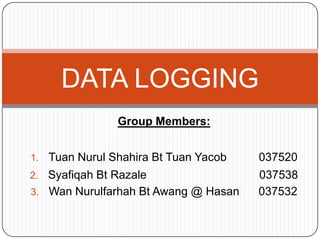
Data logging (rate of reaction)
- 1. DATA LOGGING Group Members: 1. Tuan Nurul Shahira Bt Tuan Yacob 037520 2. Syafiqah Bt Razale 037538 3. Wan Nurulfarhah Bt Awang @ Hasan 037532
- 2. The Effect of Catalyst On Rate of Reaction
- 3. Scientific Concept Catalyst is a substance that increases the rate of a chemical reaction. Catalyst speeds up a chemical reaction but is not consumed by the reaction. The higher the concentration enzyme catalase, the higher the amount of oxygen released by the destroyed hydrogen peroxides. The higher the enzymes catalase, the higher rate of colliding collision between enzyme catalase and hydrogen peroxide, more hydrogen peroxide being destroyed and released oxygen gas. +
- 4. Engage Statement: You are given two different pictures about the ways for student to their lecturer room which is located on the 6th floor. Observe the picture carefully. Based on the picture, which one is faster? Give reason. What substance have similar representation with the elevator for this situation? What will happen if the amount of that substance increased?
- 5. Empower Planning And Doing Your Experiment 3% of Pressure Hydrogen Water Test tube Sensor Peroxide Enzyme Test Tube Catalase Rack
- 6. Empower Planning And Doing Your Experiment Procedure: 1. Connect the Oxygen Gas Sensor to the computer interface. Prepare the computer for data collection by opening the file “02 (O2) Enzyme” from the Advanced Biology with Vernier folder of LoggerPro. 2. Click „Length‟ menu . 3. Change the length to 180 s, then click „ok‟ 4. Place four test tubes in a rack and label them 1, 2, 3 and 4.
- 7. 5. Fill each test tube with 3 ml of water and 3 ml of 3% of . 6. Connect the plastic tubing of the pressure sensor with the gentle half turned. 7. Initiate the enzyme catalase reaction as follow: a) Placed 1 drop of enzyme catalase into test tube 1 b) Quickly stopper the tube. c) Swirled the test tube gently. d) Connect the other plastic tubing to the top of the stopper.
- 8. e) Then, start the data collection. Continue to swirled 3 minutes of data collection. f) Once, data collector is finished, removed the stopper from the top of the test tube. 8. To determine the rate at which oxygen was produced, click analyze menu and choose curve fit, and then click pressure 9. Fold down fit equation menu and choose linear, then click „ok‟. 10. The slope will represent the rate at which oxygen was produced.
- 9. 11. Repeat the experiment with different enzyme catalase concentration with 2, 3 and 4 drops of enzyme catalase into test tube 2, 3 and 4 labeled test tubes. 12. After completing the experiment, you can show all rums of experiment by choose „Run 4‟ and then click „All runs‟. 13. Compared all the graphs.
- 10. Empower Result: Graph of Oxygen Produced
- 11. Question : 1. Which type of catalyst that being used in this experiment? 2. Which concentration of enzyme catalase having the highest rate of reaction? 3. What type of gas being produced? 4. What is the equation can be form for the production of that type of gas? 5. Compare the four graphs and give reasons. Answer : 1. Positive catalyst. This is because a positive type of catalyst will increasethe rate of reaction. 2. 4 drops of enzyme catalase. 3. Oxygen gas. 4. ( l) ( l) + (g) 5. Based the four graphs, we can see that the graph for 4 drops of enzyme catalase is more slope followed by the 3 drops of enzymes catalase, 2 drops of enzymes and the last one is graph for 1 drop of enzyme catalase. From this results it shows that the higher concentration of enzyme catalase, the higher the pressure of oxygen gas being detected by the pressure sensor, the graph also more slope. In conclusion, the higher the concentration of enzyme catalase, the higher the production of oxygen gas.
- 12. Enhance Cloth 1 Cloth 2 Statement: There are clothes that dirty with oily food residue. Which one is better to wash the cloth that dirty with cooking oil either the larger amount of powder detergent or the small amount of powder detergent? Explain.
- 13. Answer: Cloth 2 is clean better because it use the larger amount of powder detergent to clean the cloth that dirty with oily food residue. The increase amount of powder detergent would increase the rate of reaction to occur. The cloth 1 is slow reaction occur because the small amount of the powder detergent is use to clean a cloth. The detergent contains protein enzymes that classified as proteases. These enzymes increase the cleaning action of household detergent by accelerating the hydrolysis of oily food residues, so that they could be more rapidly dispersed and emulsified in water. The rate of reaction in hydrolysis of food residue is increase due the larger amount of the detergent is use. The enzyme proteases are photolytic enzymes that degraded protein by cleaving the peptide bonds, thus assisting in the removal of protein-based stain such as blood and many types of food.
- 14. Unique Feature of This Activity We can stopped the data logger whenever we want because before start the experiment, we had set the time and when the time for the experiment had finished it will stopped automatically. The rate of reaction cannot be detected by our naked eyes. So, by using the data logger the reading of rate of reaction between enzyme catalase and hydrogen peroxide can be record every one minutes per hour.
